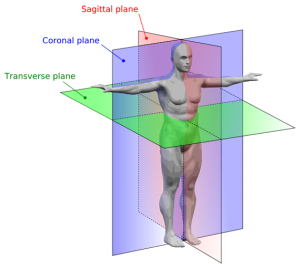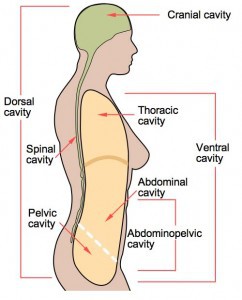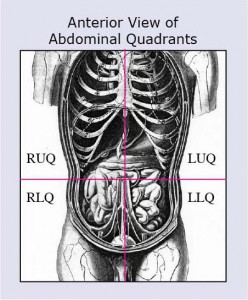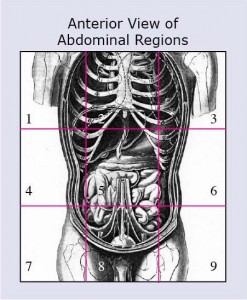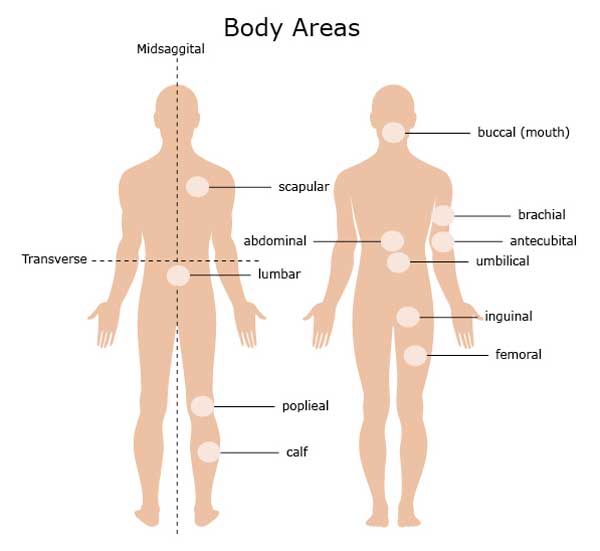Human anatomy is the study of the structure of the human body. Anatomical terms allow health care professionals to accurately communicate to others which part of the body may be affected by disorder or a disease
Terms are defined in reference to a theoretical person who is standing in what is called anatomical position (see figure below): both feet pointing forwards, arms down to the side with palms forward (thumbs pointed away from the body). The positions of the arms and legs have important implications for directional terms.
In the anatomical position, the head is upright and facing forward. In men, the penis is considered to be erect in the anatomical position e.g. the dorsal surface of the penis is actually the anterior (front-facing) surface in the flaccid state.
Ultimately communicating using anatomical terms makes it easy to communicate description of body areas regardless of the individual’s position. For example, suppose a doctor was trying to describe an area of the body to another physician on a patient who is lying face down? Descriptions would be based on anatomical position to make things simpler and to avoid any confusion.
Directional Terms
For the most part, directional terms are grouped in pairs of opposites based on the standard anatomical position.
- Superior and Inferior – Superior means above, inferior means below. E.g. The elbow is superior (above) to the hand. The foot is inferior (below) to the knee.
- Anterior and Posterior – Anterior means toward the front (chest side) of the body, posterior means toward the back.
- Medial and Lateral – Medial means toward the midline of the body, lateral means away from the midline.
- Proximal and Distal – Proximal means closest to the point of origin or trunk of the body, distal means farthest away. These terms are often used to describe the arms and legs. If you were describing the shin bone, the proximal end would be the end closest to the knee and the distal end would be the end closest to the foot. In the fingers, a proximal joint is the one closest to the wrist and a distal joint is the one farthest from the wrist.
- Superficial and Deep. Superficial means toward the body surface, deep means away from the body surface. E.g. Skin is superficial to a person’s organs. A person’s organs are deep to skin.
- Cephalad (or rostral) and Caudal. Cephalad means towards the head and caudal means towards the tail bone.
- Dorsal and ventral – dorsal refers to the back and ventral to the front. In the human body, these terms are interchangeable with posterior and anterior. However, when describing structures within the skull, a dorsal structure is closer to the top of the skull, and a ventral structure is closer to the base of the skull.
Other Directional Terms:
- Ipsilateral means on the same side— e.g. left arm is ipsilateral (on the same side) to the left leg.
- Intermediate – in between—your heart is intermediate to your lungs.
- Visceral – may be used instead of deep – typically used in reference to organs
- Palmar references the palm side of the hand.
- Plantar references the bottom of the foot.
Anatomical Reference Planes
A plane is a theoretical line that divides the body. These planes are often used to describe location of structures or to describe directionality of movement. Oftentimes, these terms are used within the context of advanced medical imaging studies such as computed tomography (CT) and magnetic resonance imaging (MRI) scans.
Main Reference Planes
- Sagittal (also known as longitudinal) plane — this vertical (top to bottom) plane divides the body into left and right sides. The theoretical plane that divides the body down the middle into equal left and right sides is known as the median sagittal plane.
- Coronal (also known as frontal) plane — a vertical plane that divides the body into front and back halves
- Transverse (also known as axial or horizontal) plane — this horizontal plane is parallel to the ground and divides the body into upper and lower halves.
- Oblique plane (not shown in the figure) is a slanted plane (at an angle) that lies between the horizontal and vertical planes.
You can see that the three basic planes (sagittal, coronal, transverse) intersect one another at right angles. For “normal” human bodies, the right and left sides are mirror images if divided right down the center by the sagittal plane as shown in the image below.
Motion about these planes can be described by an axis of movement. For instance, movement about the sagittal axis occurs in the sagittal plane e.g. bending forwards and backwards. Accordingly, movement about the transverse axis occurs in the transverse plane e.g. twisting at the waist. Finally, movement about the coronal axis occurs in the coronal plane e.g. bending your body to the left or right.
Body Cavities
Body cavities are areas in the body that contain our vital organs. The dorsal and ventral cavities are the two main cavities. The dorsal cavity is on the posterior (back side) of the body and contains the cranial and spinal cavities. The ventral cavity is on the front (anterior) of the body and is divided into the thoracic (chest) and abdominopelvic cavities.
Dorsal Cavity
The dorsal cavity is further divided into the following subcavities:
- The cranial cavity contains the brain
- The spinal (or vertebral cavity) contains the spinal cord.
Ventral Cavity
The ventral cavity is on the front of the trunk. The diaphragm (the main muscle of breathing) divides the ventral cavity into two simple subcavities: thoracic and abdominopelvic cavities.
- Thoracic cavity is superior (above) to the diaphragm and abdominopelvic cavity. It is lined by the ribs and chest wall. It is further divided into the pleural cavities (left and right) which contain the lungs, bronchi, and the mediastinum. The mediastinum contains the heart, large vessels of the heart, trachea (windpipe), upper esophagus, thymus gland, and lymph nodes.
- Abdominopelvic cavity is further divided into the abdominal and pelvic cavities.
- The abdominal cavity is between the diaphragm and the pelvis. It contains many of the gastrointestinal organs such as the stomach, intestines (except the sigmoid colon and rectum), spleen, liver, gallbladder, pancreas, adrenal glands, kidneys and ureters.
- The pelvic cavity contains the bladder, some of the reproductive organs and the rectum.
The Thoracic and Abdominopelvic Cavities
The thoracic cavity is open at the top and the abdominopelvic cavity is open at the bottom. Both cavities are bound on the back by the spine. Even though their locations are defined, the shape of these cavities can change. Breathing is the main way that the shape of these two cavities can change.
The abdominopelvic cavity changes shape similar to a water-filled balloon. When you squeeze the balloon, the balloon asymmetrically bulges. Similarly, when breathing compresses the abdominal cavity, it “bulges” into a different shape. The abdominal cavity can also change shape based on its contained volume—i.e. depending on how much you eat and drink. The more you eat and drink, the harder it is for the diaphragm to compress the abdominal cavity—which is why it is harder to breathe after a large meal. Also, an increase in volume of the abdominal cavity decreases the volume in the thoracic cavity—you can take in less air.
The thoracic cavity changes shape and volume when you breathe. When you breathe out, its volume decreases; when you breathe in, its volume increases.
Other Cavities
- Oral cavity – the space in the mouth inside the teeth and gums and is filled with the tongue when it is relaxed.
- Nasal cavity – in the nose
- Orbital cavities (left and right) – hold the eyes
- Middle ear cavities (left and right) – hold the small bones of the middle ear
- Synovial cavities – are inside the joint capsules that surround freely moving joints (such as the hip, knee, elbow, and shoulder)
Body Quadrants
Quadrants are another way our bodies are divided into regions for both diagnostic and descriptive purposes.
Abdominal Quadrants
Quadrants divide our bodies into regions for diagnostic and descriptive purposes. The quadrants are defined by drawing an imaginary line vertically (top to bottom) and horizontally (sideways) though the umbilicus (belly button). The following is a list of the organs in the four quadrants.
- Right Upper Quadrant (RUQ) – right lobe of liver, gallbladder, part of the transverse colon, part of pylorus, hepatic flexure, right kidney, and duodenum.
- Right Lower Quadrant (RLQ) – cecum, ascending colon, small intestine, appendix, bladder if distended, right ureter, right spermatic duct (men), right ovary and right tube and uterus if enlarged (women).
- Left Upper Quadrant (LUQ) – Left lobe of liver, stomach, small intestine, transverse colon, splenic flexure, pancreas, left kidney and spleen.
- Left Lower Quadrant (LLQ) – small intestine, left ureter, sigmoid flexure, descending colon, bladder if distended, left spermatic duct (men) left ovary and left tube and uterus if enlarged (women).
Body Regions
Body regions are further subdivisions of the body quadrants. They are named based off of the special function that the organs within that region perform or based on the blood or nerve supply to that region. The most widely used regional terms used are those that describe the 9 abdominal regions shown in the image to the right. The regions are named below and the corresponding regions are labeled 1-9.
Abdominal Regions
- Right (1) and left (3) hypochondriac regions – on either side of the epigastric region. Contains the diaphragm, some of the kidneys, right side of the liver, the spleen and part of the pancreas.
- Epigastric region (2) – superior (above) the umbilical region and contains most of the pancreas, part of the stomach, liver, inferior vena cava, abdominal aorta and duodenum
- Right (4) and left (6) lumbar (lateral) regions – on either side of the umbilical region. They contain portions of the large and small intestines and kidneys.
- Umbilical region (5) – area around the umbilicus (belly button). Includes sections of the large and small intestines, inferior vena cava and abdominal aorta
- Right (7) and left (9) iliac (inguinal) regions – are on either side of the hypogastric region and include portions of the large and small intestines.
- Hypogastric (pubic) (8) region – inferior (below) the umbilical region. Contains parts of the sigmoid colon, the urinary bladder and ureters, the uterus and ovaries (women), and portions of the small intestines.
Body Areas
Body areas is just another way to describe regions of the body. Below are examples of some relevant terms:
- Abdominal — relating to the abdomen.
- Antecubital — region of the arm in front of the elbow i.e. the skin crease at the elbow.
- Brachial — over the brachial artery i.e. the upper arm
- Buccal — of or relating to the cheeks or the mouth
- Calf — relating to the calf
- Femoral — relating to the femur or thigh
- Inguinal — the groin or area in lower lateral regions of the abdomen
- Lumbar — area over the lumbar spine (low back)
- Popliteal — region on the back of the knee (i.e. over the skin crease there)
- Scapular — of or relating to the area near the shoulder blade (scapula)
- Umbilical — relating to the central area of the abdomen near the belly button (the umbilicus)
